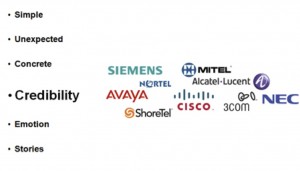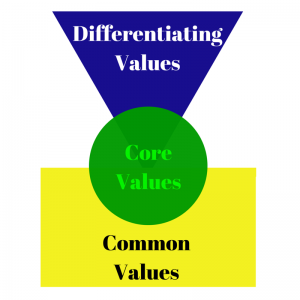When credibility can help or hinder your brand
 Working with many business-to-business (B2B) companies over the past 15 years, I have discovered that credibility is a common value embraced by marketers.
Working with many business-to-business (B2B) companies over the past 15 years, I have discovered that credibility is a common value embraced by marketers.
As a differentiating value, Credibility means believable or trustworthy; authentic or convincing. Facts are often used to prove credibility.
Why is credibility so popular among B2B marketers? Maybe it’s because they focus on trying to prove the benefits of their products and services. It’s evidenced-based marketing.
Not surprisingly, I have found it’s rare for B2B marketers to embrace the softer, more human side of their market. They tend to embrace the needs of the “businesses” instead of the “people.”
As a value, there are times when credibility can help build your brand. In fact, it’s one of the proven communication templates.
Six Communication Templates
Made to Stick is a great book for marketers who want to communicate more effectively with their various stakeholders. Authors Chip and Dan Heath provide six well-defined templates for connecting with people:
– Simple – communicate a core idea
– Unexpected – grab people’s attention by surprising them
– Concrete – ensure an idea is understood and remembered
– Credibility – give an idea believability
– Emotion – help people see the importance of an idea
– Stories – empower people to use an idea through narrative
As one of the six templates, Credibility works well for those occasions where facts and important data have relevance to the target audience.
An example here is from the IT/Telecom industry where the statement “five 9’s reliability” (meaning 99.999% reliable) has been used for many years as the basis for proving quality.
But what if competitors in this industry could make similar claims? Does it really matter if one router claims to increase productivity 5% more than another, or one application claims to provide more security than another?
When not to focus on Credibility
To determine which template to use to differentiate your brand, it’s also important to evaluate what competitors are doing. This is something not mentioned by the Heath brothers in their book.
Continuing with the example of the IT/Telecom industry, if you read the promotional materials of major players such as Cisco, Avaya, Siemens, Alcatel-Lucent, and others and you’ll see a common thread of messaging. They all focus on common B2B concerns, such as: increased productivity, reduced costs, improved efficiency, and secure and reliable.
These are all elements of the Credibility template.
 Based on the preferred communication template of credibility, it becomes visually clear that the IT/Telecom industry is one crowded space.
Based on the preferred communication template of credibility, it becomes visually clear that the IT/Telecom industry is one crowded space.
The solution?
If competitors are all using the same communications template, then consider using a different one.
This may be a difficult task if the organization has been trained to focus on features and benefits. It requires strong leadership to shift how the brand is positioned and select a different communication template.
Credibility is a powerful value, and a proven communication template. But if your competitors have also embraced it, then it might not be differentiating your brand.
What other industries crowd around the value of credibility, to the detriment of differentiating their brand?







